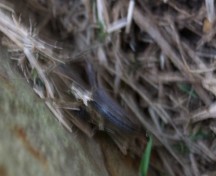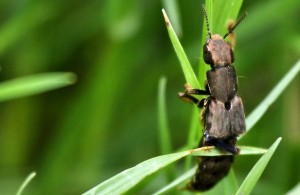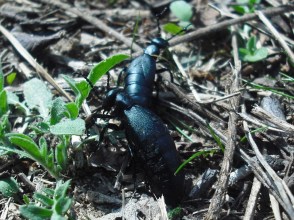Slam Poetry is a fairly recent artistic phenomemon, where composers (“slammers”) recite passionate and emotionally-charged poetry in a competitive arena; it’s usually a raucous and stirring event. I propose that, given the range of intense emotion our scaley and slippery friends can invoke, it is high time the Slime Poetry movement took centre stage. For centuries writers have captured those fleeting moments of fear, awe, sadness and, of course, beauty we herp-happy folk appreciate so much. In this installment of House of Herps #5: Slime Poetry, we explore the passion of herpers through the posts of our contributors and the kindred hearts of poets.
I suggest you stand to recite the verses, and be sure to speak loudly.
__________________________________________________________________________________________________
We start with Kay’s encounter with a “narrow fellow in the grass” at Arroyo Colorado River Blog.

Several of nature’s people
I know, and they know me;
I feel for them a transport
Of cordiality
But never met this fellow,
Attended or alone,
Without a tighter breathing,
And zero at the bone.
From A Narrow Fellow in the Grass, Emily Dickinson (1965)
Kay is a lover of poetry, especially the works of Emily Dickinson. That said, she does NOT share the authour’s evident fear of snakes. Instead she shares her joyful encounter with one of nature’s people, a “narrow fellow in the grass”: a beautiful Texas Indigo Snake.
Lucky Amber Coakley at The Birder’s Lounge has encountered an absolute bonanza of springtime herps, one of which was a tiny skink, first seen as a speedy flash of panicked blue:

Porter of readiness, miller of the
steady shudder, peripatetic
rectitude, run by the power
of the sunlit rock, it fortifies
Darwin and the idea of being late
and the missed appointment.
With its blue tail, it reminds us:
it will go on. It will not stop.
From Skink, Rodney Jones (2008)
Her little discovery calms enough to permit photographs…and displays an interesting colour change!

Seabrooke Leckie and Dan Derbyshire tag-team to share photos and info of the threatened Blanding’s Turtle at the Marvelous in nature. Dan’s photos inspire Seabrooke to recall last summer’s encounter with a Blanding’s Turtle, which was performing the common but perilous act of crossing the road.
He went right through a Stop-sign on the wrong side of the road.
He didn’t see the great big truck with overburdened load…
. . . . . . . . . . . . . . . . . . . .
These dotted lines are kinder than some vivid words to show
What happened to the trailer, compact and neat . . . but slow.
Some mangled flesh, some bits of shell were wreckage to explain
Why this dusty little turtle will not cross a road again.
From Tragedy of the Road, Don Blanding (1946)
Happily, Seabrooke’s Blanding’s Turtle did not share the same fate as Blanding’s turtle; her simple act of kindness – moving the critter from harms’ way – spared it an untimely demise.
Joan from Anybody Seen My Focus? found a small Musk Turtle in a place far more sensible than on a road: a shallow lake. After a proper photoshoot, she replaced the reptile back in its watery residence.
A helmet worn by no one has taken power.
The mother-turtle flees flying under the water.
The speed at which the little turtle darts for cover is impressive, as are the resulting photographs!
Speaking of musk, Bernard Brown at Philly Herping had a hankering for just that: “the sweet smell of success”…a successful snake hunt, that is! 
A back road pungent with musk and mint.
So beautiful, that snake. . .
From The Flower Snake, Midang So Chong-ju (1941)
He shares with us TWO beauties, and provides some excellent notes on the natural history of both species.
Snakey goodness seems to come in twos…Ted MacRae at Beetles in the Bush was fortunate enough to encounter North America’s smallest rattlesnake not once, but twice!

I found him asleep in the heat
…coiled in loose folds of silence
…I saw the wedged bulge
Of a head hard as a fist…
…(I) heard the loud seethe of life
In the dead beads of the tail
From Rattlesnake, Brewster Ghiselin (1939)
Even though this snake is small, Ted respectfully keeps his distance after the snake kindly informs him he’s too close for comfort.
Buckeyeherper (from the aptly named “Buckeye Herps” blog) is on a mission: to find the beautiful Spotted Turtle that has eluded his searches in Michigan. Spring is in the air, which means that amourous turtles should be out and about.
The silver mist engulfed.
The golden sun does heat,
The dainty spotted turtle,
In smooth pursuit of his mate,
The quiet world returns with sounds,
With blue vibrations does life continue.
Clemmys guttata, Lou Reeves (date unknown)
I think it’s fair to say his mission was accomplished, with gusto. Other reptilian beauties abound as he takes us with him on a tour of the feys.
Michelle at Rambling Woods finds herself asking, What Kind of Frogs are These? (That post title sounds like a poem itself, doesn’t it?) Frogs never fail to fascinate, and their presence in watery places seem completely integral, as noted in a classic Japanese poem:

Furu ike ya/The old pond;
kawazu tobikomu/a frog jumps in —
mizu no oto /The sound of the water.
Frog Haiku, Matsuo Bashô (1686)
Her readers help her solve the mystery of these frogs’ identity, and meanwhile, we get to enjoy some lovely photos of these beautiful pond-dwellers.
And lastly, for a touch of comedic poetry, we get to enjoy Jason’s encounter with a rather…er…furry Red-eared Slider over at xenogere.

She asks me why…I’m just a hairy guy
I’m hairy noon and night; Hair that’s a fright.
I’m hairy high and low,
Don’t ask me why; don’t know!
It’s not for lack of bread
Like the Grateful Dead; darling!
From Hair, James Rado & Gerome Ragni (1967)
As for this Geek, spring has finally been ushered in with the Anuran arias I associate with the new season. The songs of Spring Peepers sound like poetry to these ears, even if they are unseasonably early!
_______________________________________________________________
May’s edition of HoH will be hosted by Bernard Brown at Philly Herping … submit your herpy contributions by May 15!




























